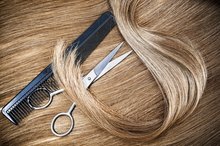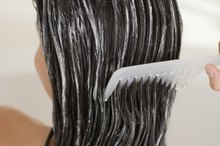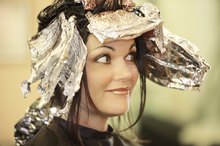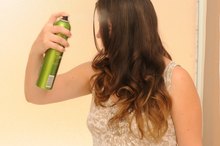Damaged Hair Cuticles
Damaged hair cuticles can cause split ends and give your hair a rough look. Your hair cuticles could be damaged for many reasons -- both from internal and external factors. Hair is delicate and should be handled as such. Fortunately, treatments for getting your hair back to a healthy status exist.
Identification
Hair consists of many layers 1. The outer layer of hair is the cuticle, which is made up of layers of protein, called keratin. It houses and protects the cortex and is strong. The hair cuticle has a structure of overlapping scales in a vertical alignment. The cortex is what gives hair volume and also controls flexibility and elasticity. When the hair cuticle is damaged, the tough structure no longer holds the hair together and the hair fibers dislodge and split.
- Hair consists of many layers 1.
- The cortex is what gives hair volume and also controls flexibility and elasticity.
Causes
How to Restructure Brittle Hair
Learn More
Healthy hair has closed hair cuticles. Factors that change the cuticle’s surface can include your shampoo.
Some strong shampoos not only strip the hair of its natural oils but also injure the cuticle by tearing up the overlapping scales.
Touching your hair too much, from either brushing or finger twirling, will harm the cuticle as well. Hair and styling accessories put a lot of stress on hair. Ponytail holders, combs and clips can eventually wear away the hair cuticle if used day after day.
Any amount of heat on your hair can cause damage by lifting the overlapping scales where water and other substances can enter. Heat may also remove pieces of cuticle, causing a porous surface that results in weakened hair. Chlorine found in swimming pools and the salt found in the ocean can damage your hair cuticles as well.
- Healthy hair has closed hair cuticles.
- Ponytail holders, combs and clips can eventually wear away the hair cuticle if used day after day.
Expert Insight
Cuticles are the most exposed components of hair fibers in regards to grooming and environmental stresses. When hair is heated, water evaporates rapidly outside and inside the hair. This dehydration leads to changes within the cortex. A 1998 study published in the “Journal of Cosmetic Science” looked at the use of blow dryers on wet hair.
The results showed that cracks appear when the hair cuticles undergo a drastic reduction in water hydration status. The cracks occurred all the way through the three layers of hair. The outer cuticles became brittle, rigid and cracked from the swelling pressure of all three layers.
- Cuticles are the most exposed components of hair fibers in regards to grooming and environmental stresses.
- The outer cuticles became brittle, rigid and cracked from the swelling pressure of all three layers.
Treatment
How to Restore Hair Elasticity
Learn More
The best method of treatment for damaged hair cuticles is to avoid the causes. When your hair starts to break, it typically begins at the end, known as split ends. Trimming your hair on a regular basis won’t prevent the damage, but it will stop it from getting worse. Hair is best when left alone; try not to touch it too much or over brush it. Mild shampoos are gentler on hair cuticles, but you don’t need to wash it every day. Use a conditioner in place of, as well as in conjunction with, your shampoo to help keep your hair strong, clean and moisturized. Avoid chemically treating or dyeing your hair. Consider using hot oil treatments to help prevent your hair from breaking and splitting.
- The best method of treatment for damaged hair cuticles is to avoid the causes.
- Trimming your hair on a regular basis won’t prevent the damage, but it will stop it from getting worse.
Considerations
A healthful diet and adequate water intake are essential for healthy hair. While vitamin deficiencies or malnutrition do not directly affect hair cuticles, it can make hair vulnerable to the factors that can damage the cuticle.
Related Articles
References
- Women Fitness: Enemies of Healthy Hair
- American Society of Clinical Oncology. Hair loss of alopecia. Updated August, 2018.
- Saed S, Ibrahim O, Bergfeld WF. Hair camouflage: A comprehensive review. Int J Womens Dermatol. 2017;3(1 Suppl):S75–S80. Published 2017 Feb 16. doi:10.1016/j.ijwd.2017.02.016
- Dua P, Heiland MF, Kracen AC, Deshields TL. Cancer-related hair loss: a selective review of the alopecia research literature. Psychooncology. 2017;26(4):438-443. doi:10.1002/pon.4039
- National Cancer Institute. Hair loss (alopecia) and cancer treatment. Updated January 15, 2020.
Writer Bio
Nicole Adams is an accomplished writer, publishing in print and online. She has submitted hundreds of articles for websites, including CBS Local and Education.com. Adams earned a Bachelor of Science in psychology with concentrated studies in health and nutrition, and animal behavior and nutrition. She loves to cook and volunteers in animal rescue.









